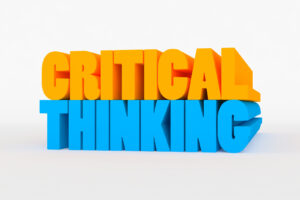Organization Change Management (OCM)
Effective change management absolutely requires us to cut loose our curiosity. Our curiosity must be extreme. Our curiosity must be continuous. Situational awareness must be uppermost.
Read MoreCritical thinking is the disciplined process of formulating information by observation, experience, reflection, reasoning, and communication. The critical thinking process drives mindfulness – the activities of conceptualizing, applying, analyzing, synthesizing, and evaluating information as a guide to belief and action. Without critical thinking, beliefs and actions are misguided, senseless, thoughtless, unmindful – not at all in concert with real situations.
Read MoreThe key to effective relationships and successful communications, from the Behavior Style point of view, is to eliminate the Golden Rule: Do unto others as you would have them do unto you” and embrace the Platinum Rule: “Do unto others as they would have you do unto them.”
Read MoreHaving the knowledge to predict the interaction problems we may encounter with other people provides us with a basis for improving the quality of our interactions. This improvement in our “situational awareness” gives us the ability to better control the outcomes of our interactions with others.
Read More“Cultural awareness” means not only being aware of other cultures, but our own as well. Being aware of others’ culture and customs is critical. But an equally important question to ask ourselves is, “How are our customs and practices different from those we are engaging?”
Read MorePerceptions are our awareness and understanding of situations as determined by our senses (seeing, hearing, touching, smelling, tasting, and feeling). We absorb more than a thousand impressions per minute through our senses. These impressions shape how we process information, how we reach conclusions, and how we form opinions. They constitute our version of the truth, our biases, our likes, and our dislikes.
Read MoreDr. Wilder Penfield (1891-1976) was a neurosurgeon. In 1956 he published his work on Speech and Brain Mechanisms. During his surgical treatments on severely mentally ill patients, he discovered that stimulating different parts of the brain caused the patients to experience a variety of emotions. He found that the brain, through electrical stimulations, releases chemicals that activate the nervous system. These chemicals would induce feelings of fear, excitement, depression, sadness, aggression, anxiety, happiness, etc. He referred to this phenomenon as the chemistry of thought.
Read MoreThe purpose of this series is to inquire, examine, study, and uncover some of the facts, truths, realities, and complexities of change management. The goal is to build a solid understanding and foundation for effectively dealing with change implementation challenges.
Read MoreDo you manage the culture? Or does it manage you? How do we determine its effectiveness and influence throughout the organization?
Read More








